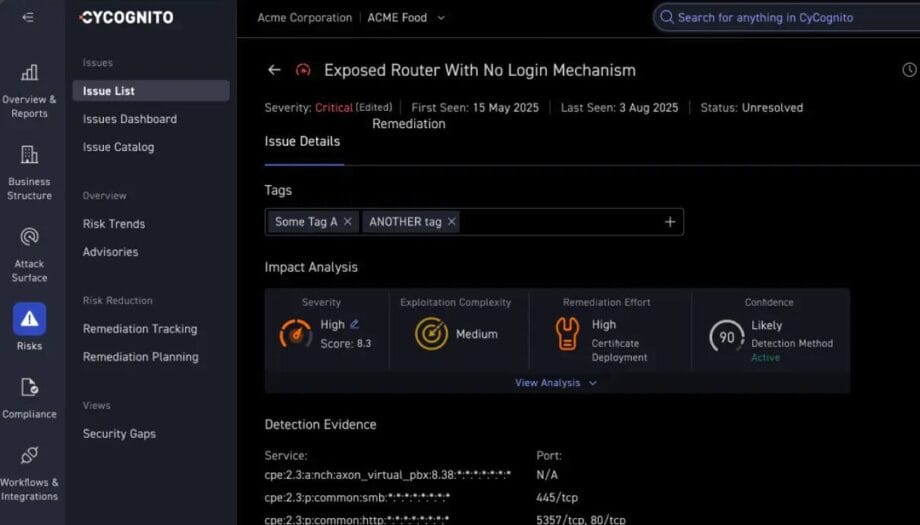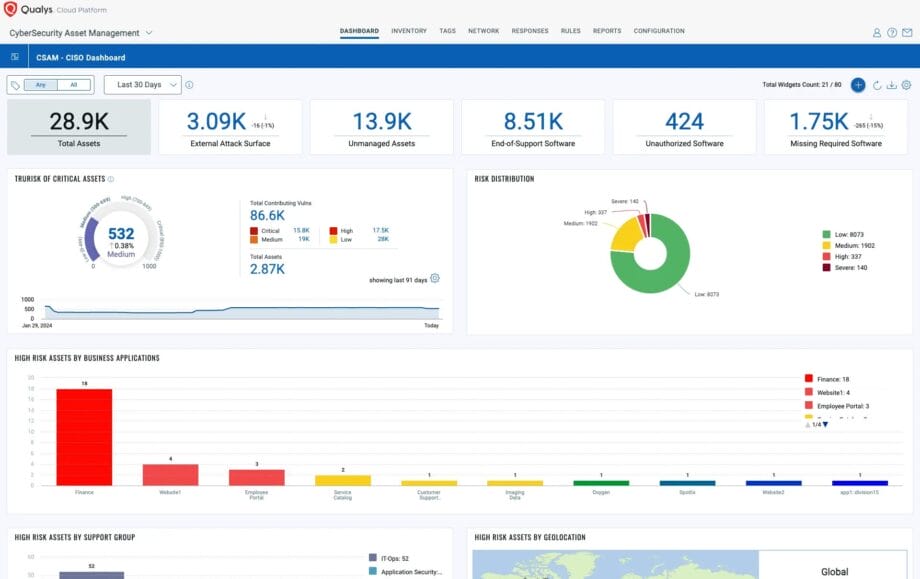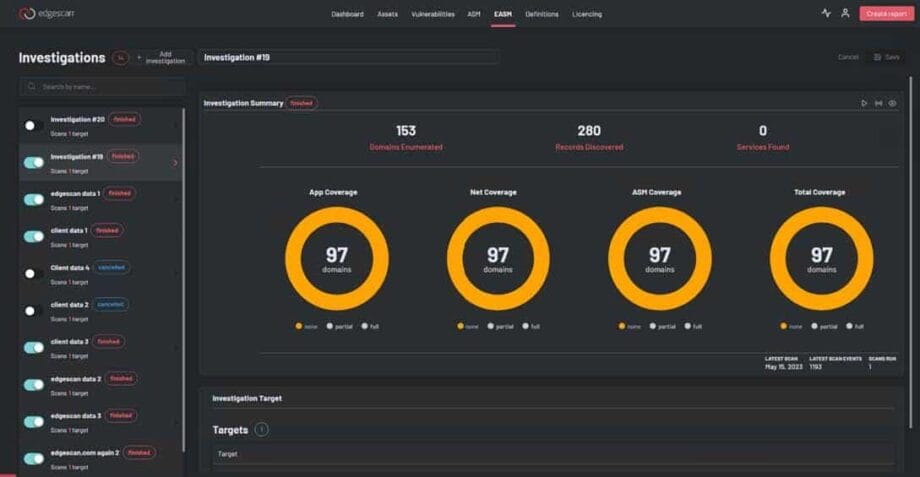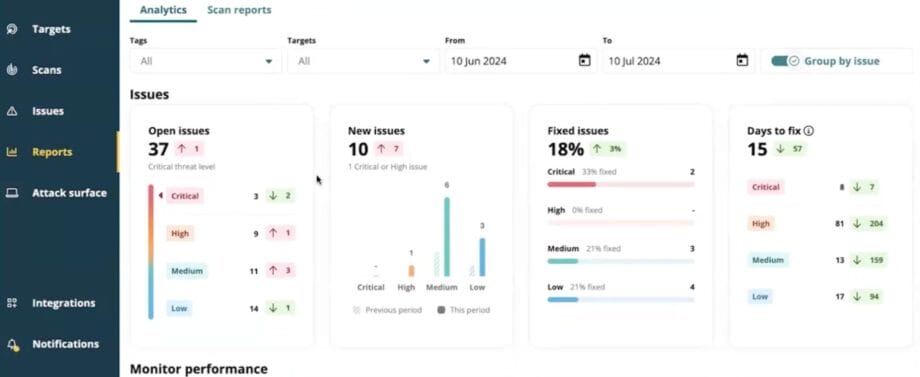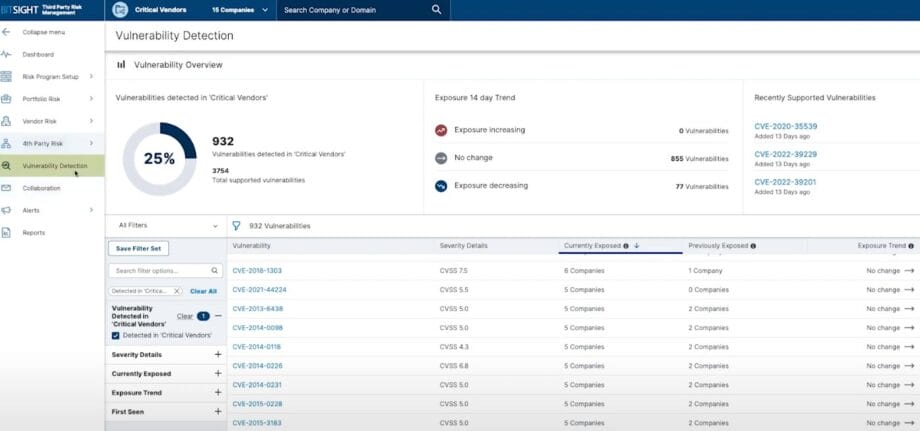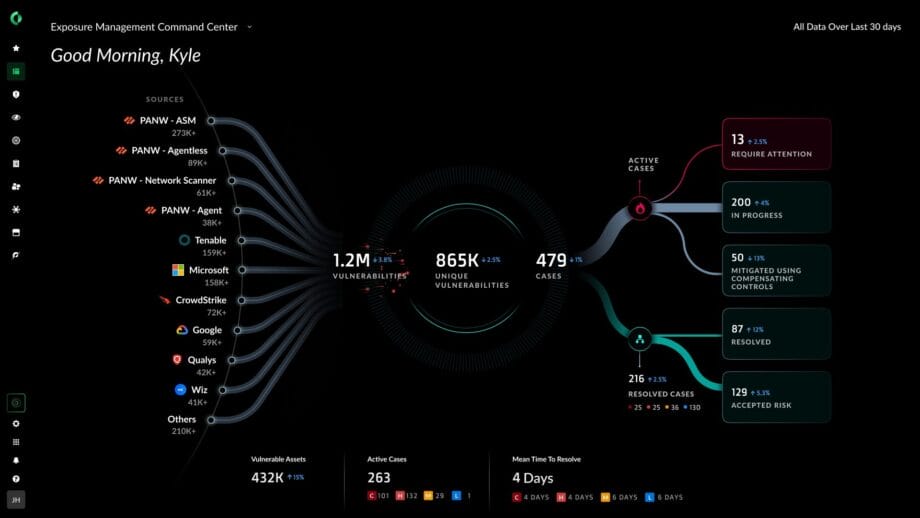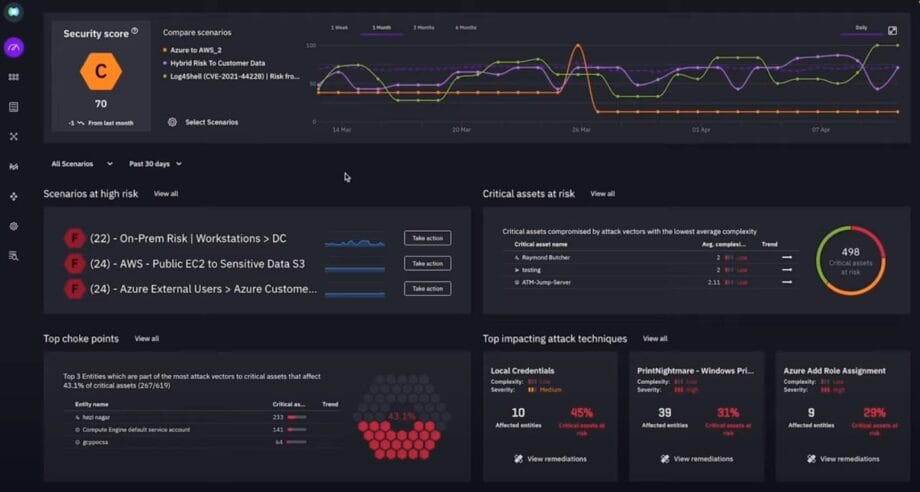Exposure management refers to a process that continuously analyzes a company’s digital assets to identify and mitigate cyber threats. This proactive approach to IT security differs from traditional vulnerability management workflows, which typically focus on patching known issues.
Enterprises need exposure management due to the size and complexity of their digital infrastructure. Large businesses leverage different types of devices, network components, custom apps built for in-house use, and sprawling server infrastructure to manage their operations, making it easy for IT threats to quietly grow under the radar.
Simply put, exposure management platforms help established organizations closely monitor their IT health and attack surface to help them effectively evade the dangers of cyber attacks.
In this article, let’s look at the top 7 exposure management solutions for enterprises in 2026.
1. CyCognito
CyCognito is an industry-leading exposure management platform that automates the discovery and regular testing of digital assets. The tool actively tests the resilience of existing security measures to reveal hidden vulnerabilities before hackers do.
It elevates enterprise exposure management through the following key capabilities:
- Asset discovery: CyCognito excels at mapping the entire IT infrastructure, including hidden assets, such as employee-procured SaaS tools and old servers, to expose 20x more potential vulnerabilities.
- Threat contextualization: Provides business and technical context to help professionals accurately assess the true impact of a threat, enabling smarter prioritization.
- Continuous monitoring: Checks the IT inventory daily to update the record of hardware, software, cloud services, and other digital assets for complete end-to-end visibility.
- Attack surface mapping: Identifies all possible externally facing entry points by malicious agents and visualizes how they can compromise the enterprise’s IT infrastructure.
- Exploit intelligence: Estimates the real-world exploitability of potential vulnerabilities, enhancing the threat prioritization further.
- AI-powered search and analytics: Learn from past security incidents and gain actionable insights that accelerate investigation and remediation.
Due to such a comprehensive suite of tools, this exposure management platform has secured the top spot on our list.
Additionally, its track record of helping some big names like Tesco, Panasonic, Colgate-Palmolive, and Hitachi proves CyCognito’s ability to bolster exposure management systems for large, global enterprises.
2. Qualys
Qualys’ Enterprise TruRisk Platform exposes cyber threats with its real-time unified asset visibility and threat detection capabilities. The tool provides teams with a consolidated view of various security vitals, such as endpoint coverage percentages, patch compliance rate, mean time to detect, and unauthorized access attempts.
The solution’s key capabilities include:
- Asset discovery and inventory: Automates the identification of different assets from all classes, such as IT, cloud, and endpoint.
- External attack surface management: Analyzes connected devices from the attacker’s perspective to spot vulnerabilities.
- Continuous monitoring: Detects configuration drifts, vulnerabilities, and exposure shifts in real time.
The platform is trusted by many large businesses across industries, such as Sky, Capital One, and Oracle.
3. Edgescan
Edgescan blends its asset management and security testing capabilities with human experts’ skills to mitigate IT risks. The platform can help enterprises deal with threats across networks, applications, APIs, and cloud environments.
Some core offerings of this solution include:
- Full-stack coverage: Discovers and maps the attack surface for each component or system in an organization’s IT infrastructure.
- Integrations and API support: Can be easily integrated into existing enterprise-grade workflows, including legacy software.
- Expert support (CREST/OSCP-certified analysts): Allows brands to leverage human intelligence and insight for vulnerability validation and remediation guidance.
Brands in industries like financial services, healthcare, and technology use this platform to protect their data and operations from hackers.
4. Intruder
Intruder specializes in proactive discovery, monitoring, and prioritization of threats within an enterprise’s digital footprint. The platform focuses on finding the weaknesses and their remedies before attackers exploit them.
Teams can look forward to the following key features:
- Asset and attack surface discovery: Identifies exposed assets and endpoints across the business’s IT infrastructure.
- Monitoring for exposure changes: Real-time tracking of device and systems’ vitals and alerts human experts immediately after vulnerabilities are detected.
- Cloud connector: Integrates with popular cloud service providers like AWS, Azure, and Cloudflare for faster enterprise adoption.
This exposure management platform is trusted by many leading brands across industries, including Fujifilm, Einhell, and the NHS.
5. BitSight
BitSight is a cyber risk intelligence platform with robust exposure management capabilities that help organizations to map, monitor, and prioritize cyber threats across their digital ecosystem.
The solution’s core offerings for IT security teams include:
- Asset and attack surface discovery and mapping: Scans the entire network to take inventory of every device, server, and network component to identify potential areas of entry.
- External attack surface management: Tracks the behavior of external devices and user actions across third-party systems, such as supply chain and vendor collaboration.
- Continuous monitoring and real-time alerts: Regularly checks the network to find malicious agents and notifies human experts after discovering issues.
The exposure management platform helps many global organizations like Chipotle, NASA, and Schneider Electric. BitSight protects over 3500 enterprises across various industries, showcasing its versatility in boosting cyber resilience.
6. Cortex
Cortex Exposure Management Platform, developed by Palo Alto Networks, leverages AI to prioritize threats detected in real-time to strengthen IT security. Its exposure mapping and detection capabilities have established Cortex as a leader in the Forrester Wave for Attack Surface Management report.
The solution’s core offerings include:
- Attack vector and exposure mapping: Finds vulnerabilities across networks, cloud, endpoints, and third-party tools to provide a unified view of exposures.
- Continuous monitoring of exposure drift: Real-time tracking capabilities surface threats and misconfigurations as they emerge, ensuring proactiveness.
- Exposure score and trend analytics: Makes it easy for human experts to rank threats and spot cyber risk patterns to implement long-term solutions.
Palo Alto Networks’ Cortex helps Salesforce, Dell Technologies, and NetApp with exposure management.
7. XM Cyber
XM Cyber maps attack paths across hybrid infrastructures to identify exposures and prioritize them for effective resolution. The Continuous Exposure Management (CEM) platform helps enterprises understand how vulnerabilities can be exploited to facilitate remediation.
The key capabilities include:
- Asset and exposure discovery: Reveals potential risks across internal, external, and hybrid devices and environments in a unified dashboard.
- Exploit visualization and analysis: View the hack from the attacker’s perspective to assess and validate the threat.
- Real-time monitoring of IT assets: Secure the network with regular scanning and inventory management tools.
Established enterprises like Amadeus CRS, STIHL, and Telefónica trust XM Cyber for elevating their exposure management workflows.
How to Choose the Right Exposure Management Solution

At first glance, any of the above seven exposure management platforms might appear as a potential fit. This can make it difficult for enterprises to make the right choice. Here are four steps that will help busy teams spot the ideal option.
1. Define Your Security Goals
Within the discipline of exposure management, each business might have different approaches and priorities. For some, the goal might be to reduce vulnerabilities by closing open ends. Others may prioritize achieving regulatory compliance.
Identifying these objectives in a tangible manner helps leaders to pick tools that are specialized for that purpose.
2. Assess Vendor Capabilities
The second step is to analyze the features and capabilities of the platforms under consideration.
Typically, enterprises should go with platforms that provide comprehensive attack surface discovery toolkits with in-built integrations to popular cyber tools and suites. It is also advantageous to opt for platforms with API-first foundations, as they often facilitate cost-effective scalability.
3. Verify Scalability and Real-World Performance
Speaking of scalability, teams should ensure that their exposure management platform can potentially handle millions of devices and systems across distributed networks. Check the vendor’s past record and see if they’ve helped large MNCs protect their digital ecosystems.
Customer case studies also offer insights into real-time performance and resilience of the IT exposure management solution.
4. Review Vendor Support and Innovation Roadmaps
The most valuable tool is the one that is used to its fullest potential. Before selecting an exposure management platform, IT security professionals should evaluate the vendor’s customer support quality. Additionally, it’s useful to look at the training resources and the clarity of help documents.
On top of that, go through the product update or release notes to understand how the tool has evolved over the past few years. A platform that receives patches and updates regularly future-proofs the enterprise exposure management process.
Wrapping Up

The IT infrastructure of enterprises is growing increasingly complex. This increases the instances of hidden assets, misconfigurations, and unprotected endpoints. Therefore, it’s pivotal for these organizations to adopt comprehensive exposure management platforms for better security.
In this article, we reviewed seven leading platforms that specialize in taking inventory of digital assets and finding vulnerabilities before the hackers do.
CyCognito stands out for its automated discovery and AI-powered actionable insights. Qualys is effective for asset intelligence and integrates easily into enterprise workflows. Edgescan combines automation with human expert validation for better threat detection accuracy.
Intruder is quite effective at real-time monitoring of IT assets across networks. BitSight offers in-depth visibility into internal and external cyber assets. Cortex specializes in risk prioritization through AI-powered analytics. XM Cyber highlights exposures via attack path mapping.
Enterprises should identify their digital security goals, look for the corresponding features, validate performance, and ensure the tool is future-proof to make the right choice.
FAQs

What are the best exposure management solutions for enterprises in 2026?
Top solutions include CyCognito, Qualys, and BitSight. Each platform offers unique strengths, from automated discovery and contextual risk analysis to continuous monitoring and attack path mapping, making them highly effective for enterprises.
Which platforms excel at attack surface mapping and continuous monitoring?
CyCognito, Edgescan, and XM Cyber excel at detailed attack surface mapping and continuous exposure monitoring. These capabilities help organizations maintain visibility into evolving risks across internal, external, and cloud environments.
How do exposure management tools reduce enterprise cyber risk?
Exposure management tools reduce risk by continuously identifying vulnerabilities, mapping attack paths, and prioritizing threats based on exploitability and business impact. This enables faster remediation, reduces attack opportunities, and aligns security resources with the most critical risks.
What key features should organizations look for when selecting a platform?
Organizations should prioritize asset discovery, attack surface mapping, continuous monitoring, contextual risk analytics, and integrations with existing tools. Strong vendor support, scalability, and a clear innovation roadmap are also essential to ensure long-term effectiveness and resilience.
